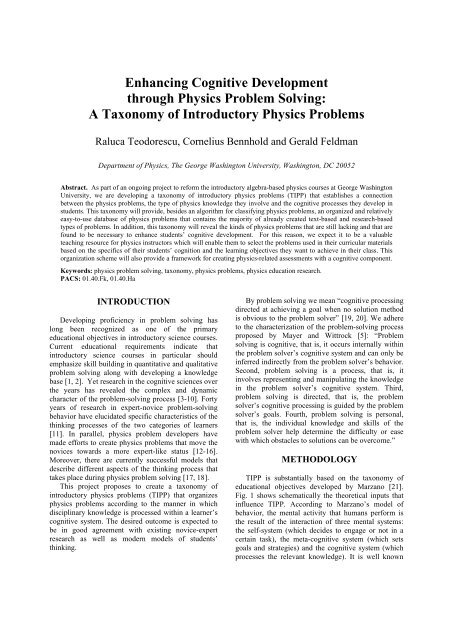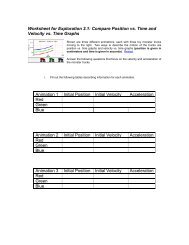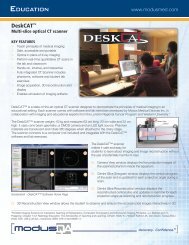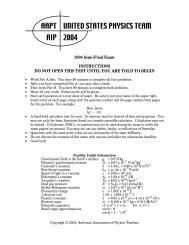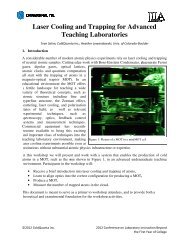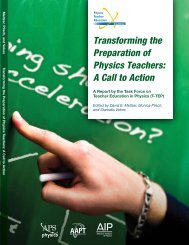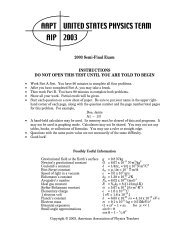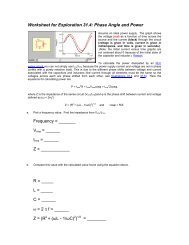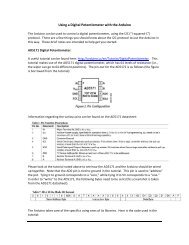A Taxonomy of Introductory Physics Problems - comPADRE
A Taxonomy of Introductory Physics Problems - comPADRE
A Taxonomy of Introductory Physics Problems - comPADRE
You also want an ePaper? Increase the reach of your titles
YUMPU automatically turns print PDFs into web optimized ePapers that Google loves.
Enhancing Cognitive Developmentthrough <strong>Physics</strong> Problem Solving:A <strong>Taxonomy</strong> <strong>of</strong> <strong>Introductory</strong> <strong>Physics</strong> <strong>Problems</strong>Raluca Teodorescu, Cornelius Bennhold and Gerald FeldmanDepartment <strong>of</strong> <strong>Physics</strong>, The George Washington University, Washington, DC 20052Abstract. As part <strong>of</strong> an ongoing project to reform the introductory algebra-based physics courses at George WashingtonUniversity, we are developing a taxonomy <strong>of</strong> introductory physics problems (TIPP) that establishes a connectionbetween the physics problems, the type <strong>of</strong> physics knowledge they involve and the cognitive processes they develop instudents. This taxonomy will provide, besides an algorithm for classifying physics problems, an organized and relativelyeasy-to-use database <strong>of</strong> physics problems that contains the majority <strong>of</strong> already created text-based and research-basedtypes <strong>of</strong> problems. In addition, this taxonomy will reveal the kinds <strong>of</strong> physics problems that are still lacking and that arefound to be necessary to enhance students’ cognitive development. For this reason, we expect it to be a valuableteaching resource for physics instructors which will enable them to select the problems used in their curricular materialsbased on the specifics <strong>of</strong> their students’ cognition and the learning objectives they want to achieve in their class. Thisorganization scheme will also provide a framework for creating physics-related assessments with a cognitive component.Keywords: physics problem solving, taxonomy, physics problems, physics education research.PACS: 01.40.Fk, 01.40.HaINTRODUCTIONDeveloping pr<strong>of</strong>iciency in problem solving haslong been recognized as one <strong>of</strong> the primaryeducational objectives in introductory science courses.Current educational requirements indicate thatintroductory science courses in particular shouldemphasize skill building in quantitative and qualitativeproblem solving along with developing a knowledgebase [1, 2]. Yet research in the cognitive sciences overthe years has revealed the complex and dynamiccharacter <strong>of</strong> the problem-solving process [3-10]. Fortyyears <strong>of</strong> research in expert-novice problem-solvingbehavior have elucidated specific characteristics <strong>of</strong> thethinking processes <strong>of</strong> the two categories <strong>of</strong> learners[11]. In parallel, physics problem developers havemade efforts to create physics problems that move thenovices towards a more expert-like status [12-16].Moreover, there are currently successful models thatdescribe different aspects <strong>of</strong> the thinking process thattakes place during physics problem solving [17, 18].This project proposes to create a taxonomy <strong>of</strong>introductory physics problems (TIPP) that organizesphysics problems according to the manner in whichdisciplinary knowledge is processed within a learner’scognitive system. The desired outcome is expected tobe in good agreement with existing novice-expertresearch as well as modern models <strong>of</strong> students’thinking.By problem solving we mean “cognitive processingdirected at achieving a goal when no solution methodis obvious to the problem solver” [19, 20]. We adhereto the characterization <strong>of</strong> the problem-solving processproposed by Mayer and Wittrock [5]: “<strong>Problems</strong>olving is cognitive, that is, it occurs internally withinthe problem solver’s cognitive system and can only beinferred indirectly from the problem solver’s behavior.Second, problem solving is a process, that is, itinvolves representing and manipulating the knowledgein the problem solver’s cognitive system. Third,problem solving is directed, that is, the problemsolver’s cognitive processing is guided by the problemsolver’s goals. Fourth, problem solving is personal,that is, the individual knowledge and skills <strong>of</strong> theproblem solver help determine the difficulty or easewith which obstacles to solutions can be overcome.”METHODOLOGYTIPP is substantially based on the taxonomy <strong>of</strong>educational objectives developed by Marzano [21].Fig. 1 shows schematically the theoretical inputs thatinfluence TIPP. According to Marzano’s model <strong>of</strong>behavior, the mental activity that humans perform isthe result <strong>of</strong> the interaction <strong>of</strong> three mental systems:the self-system (which decides to engage or not in acertain task), the meta-cognitive system (which setsgoals and strategies) and the cognitive system (whichprocesses the relevant knowledge). It is well known
that what students believe about physics as a scienceand what they expect from their physics coursesdetermine their attitude and motivation towards theprocess <strong>of</strong> learning physics. Ultimately, those factorsinfluence their overall achievement in a physicscourse. For the purpose <strong>of</strong> this project we will restrictourselves to the cognitive system and not include themeta-cognitive aspects in our taxonomy.<strong>Physics</strong>knowledgeCognitivescienceContemporaryeducationalrequirementsExisting collections<strong>of</strong> physics problemsTIPPModern models <strong>of</strong>student thinkingResearch onnovice-expertphysics problemsolving behaviorFIGURE 1. The theoretical basis <strong>of</strong> the <strong>Taxonomy</strong> <strong>of</strong><strong>Introductory</strong> <strong>Physics</strong> <strong>Problems</strong> (TIPP).While developing TIPP we address the followingquestions: Can physics problems be categorizedaccording to cognitive processes and knowledgedomains? What is the relationship between physicsproblems, knowledge domains and cognitiveprocesses? Are there cognitive processes that are notactivated by the existing physics problems? FollowingMarzano’s taxonomy [21], we have developed analgorithm to organize physics problems according to atwo-dimensional scheme. The first dimension <strong>of</strong> TIPPrefers to the knowledge domain that is involved in acertain problem while the second deals with thecognitive processes that a solver needs to perform inorder to solve it. These two dimensions arefundamentally different. The knowledge domainsencountered in physics problems are referred to:declarative knowledge or information and proceduralknowledge or mental procedures. The cognitiveprocesses required to solve physics problems are:retrieval, comprehension, and analysis and knowledgeutilization. Fig. 2 provides succinct descriptions <strong>of</strong>these complex cognitive processes, their componentprocesses and how they act on different types <strong>of</strong>knowledge. All <strong>of</strong> the cognitive processes operate inthe same manner on both types <strong>of</strong> knowledge, with theone exception <strong>of</strong> retrieval — this acts on informationdifferently than on mental procedures (as shown inFig. 2). These four cognitive processes are hierarchicalrelative to the level <strong>of</strong> consciousness required tocontrol their execution [21].COGNITIVE PROCESSES4) Knowledge utilization – the solver applies or usesknowledge to create new products and new ideas. Thefocus here is on the products and ideas, not on theknowledge.Component processes: decision making, problem solving,experimenting, investigating.Much more consciousprocessing necessaryfor control3) Analysis – the solver elaborates on the knowledge ascomprehended, examines knowledge in fine detail andgenerates new conclusions. The focus here is on theknowledge.Component processes: matching, classifying, analyzingerrors and generalizing and specifying.More conscious processingnecessary for control2) Comprehension – the solver translates knowledge intoa form appropriate for storage in permanent memory.Component processes: integrating and symbolizing.Some conscious processingnecessary for control1) Retrieval – the solver activates and transfers knowledgefrom permanent memory to working memory. The process<strong>of</strong> retrieval depends on the type <strong>of</strong> knowledge that has tobe retrieved. Information is recognized and recalled, whilemental procedures are also executed.Declarative: vocabularyterms, facts. time sequences,generalizations and principlesOPERATE ONKNOWLEDGE DOMAINSProcedural: single rules,algorithms, tactics,macro-proceduresFIGURE 2. The cognitive processing <strong>of</strong> knowledgeaccording to Marzano [21].
How do we label a physics problem?To characterize an individual physics problem, wehave defined the following parameters: the type <strong>of</strong> knowledge involved in the problem the highest complex cognitive process that isnecessary to solve it (for both information andmental procedures) the number <strong>of</strong> intermediate complex cognitiveprocesses required to solve it (with respect toinformation and mental procedures).Example Problem: Rank each case from thehighest to the lowest acceleration based on thedrawings shown in the figure below. Assume allaccelerations are constant and use the coordinatesystem specified in the drawing. Note: zero is greaterthan negative acceleration, and ties are possible. [22]type <strong>of</strong> knowledge – the problem involves bothdeclarative and procedural knowledge;number <strong>of</strong> cognitive processes involved‣ for information: retrieval, comprehensionand analysis;‣ for mental procedures: retrieval;highest cognitive process involved‣ for information: analysis;‣ for mental procedures: retrieval.How do we build different classes <strong>of</strong>physics problems?Depending on the purpose <strong>of</strong> the problemclassification, meaningful groups <strong>of</strong> physics problemswith similar parameters can be defined. Forinstructional needs, we find that a classification takinginto account the type <strong>of</strong> knowledge and the highestcomplex cognitive process required to solve theproblem is <strong>of</strong>ten enough. However, for research andassessment purposes, a finer-grained characterization<strong>of</strong> physics problems is needed, which also includes thecomponent cognitive processes and the type <strong>of</strong>declarative or procedural knowledge (refer to Fig. 2).TESTINGA student required to solve this problem should knowthe concepts <strong>of</strong> velocity and acceleration. Thereforewe conclude that the problem involves declarativeknowledge. Also, the student should know thealgorithms <strong>of</strong> interpreting the diagrams. Hence theproblem involves procedural knowledge as well. Thesetwo types <strong>of</strong> knowledge are processed in differentways during the problem solving protocol. Concerningdeclarative knowledge, the student has to: recall the concepts <strong>of</strong> velocity andacceleration; decide what are the key elements that need tobe taken into account (integrate the facts); represent the information (symbolize the facts); rank the time sequences.Regarding procedural knowledge the student needs toexecute the algorithm <strong>of</strong> extracting the informationfrom diagrams.In conclusion, here is how this problem would beclassified according to TIPP (refer to Fig. 2):The validity <strong>of</strong> our taxonomy will be established inthe few ways [23]. First, Marzano’s taxonomy will beconfronted with the existing cognitive science andexpert-novice research concerning physics problemsolving. This will be done in order to ensure welldocumentedand complete descriptions <strong>of</strong> the cognitiveprocesses that take place during physics problemsolving. Second, we will evaluate the extent to whichthe taxonomy is in agreement with modern models <strong>of</strong>students thinking. In this way we seek to adaptMarzano’s taxonomy to physics problem solving.Third, we will check if certain cognitive processesassigned to a problem (using TIPP) are in fact used bystudents when they solve it. To do this, we will use 5PER articles that publish extensive interviews withstudents solving physics problems.To assess the reliability <strong>of</strong> our classificationscheme, we are selecting from [11-16, 24] a set <strong>of</strong>about 100 text-based and PER-based physics problemswith a high degree <strong>of</strong> diversity. These problems willfirst be categorized in terms <strong>of</strong> TIPP parameters by theproposal team, and then they will be presented toothers who will make an independent categorization.The results for the assigned parameters will becompared to the proposal team results. As a statisticalmeasure, Cohen’s kappa coefficient [25] will becalculated in order to determine the degree <strong>of</strong> interraterreliability. Moreover, the process will be
epeated at a later time to verify that the results do notvary over time (stability reliability or “test-retest”reliability).CONCLUSIONSWe are developing a taxonomy for introductoryphysics problems that can be used for designingcurricular materials with a cognitive component andfor modeling the physics problem solving process.While doing so, we analyze existing collections <strong>of</strong>physics problems and aim to identify the cognitiveprocess needed to solve them. After an extensivereview <strong>of</strong> text-books we find that, for the knowledgedomain <strong>of</strong> information, most standard text-bookproblems engage cognitive processes up to analysis,while PER-based problems reach the cognitive level <strong>of</strong>knowledge utilization. With respect to mentalprocedures, we find that text-books contain very fewproblems that require cognitive processes higher thanretrieval, while some PER-based problems go up toanalysis.ACKNOWLEDGMENTSWe thank to Alan van Heuvelen, Gay Stewart,Alan Giambattista, Joe Redish and Pat Heller forfruitful discussions and comments regarding our work.We would also like to acknowledge the UMD PERGmembers for hosting interesting PER seminars that weattended.REFERENCES1. NRC, National Science Education Standards.Washington, DC: National Academy Press, 1996.2. AAAS Benchmarks for Scientific Literacy. New York:Oxford University Press, 1993.3. B. H. Ross, “Cognitive Science: Problem Solving AndLearning For <strong>Physics</strong> Education” in <strong>Physics</strong> EducationResearch Conference 2007, Greensboro, NC, 2007 .4. L. D. Conlin, A. Gupta, R. E. Scherr and D. Hammer,“The Dynamics <strong>of</strong> Students’ Behaviors and Reasoningduring Collaborative <strong>Physics</strong> Tutorial Sessions” in<strong>Physics</strong> Education Research Conference-2007,Greensboro, NC, 2007.5. R. E. Mayer and M. C. Wittrock, “Problem Solving” inHandbook <strong>of</strong> Educational Psychology, 2 nd Ed., edited byH. Alexander and R. Winnie, (Wiley, NY, 2006), pp.287- 303.6. W. J. Gerace and I. D. Beatty, Teaching vs. Learning:Changing Perspectives on Problem Solving in <strong>Physics</strong>Education, Invited talk at the 9 th Conference <strong>of</strong> theCyprus <strong>Physics</strong> Association and Greek <strong>Physics</strong>Association, Nicosia, Cyprus, 2005.7. E. F. Redish, Teaching <strong>Physics</strong> with the <strong>Physics</strong> Suite,(John Wiley & Sons, Hoboken, 2003).8. R. J. Dufresne, W. J. Gerace, J. P. Mestre and W. L.Leonard, ASK.IT/A2L, University <strong>of</strong> MassachusettsTechnical Report UMPERG-2000#09-SEP#1-28pp.9. R. E. Mayer, Instructional Science 26, 49-63 (1998).10. J. Clement, “Use <strong>of</strong> Physical Intuition and ImagisticSimulation in Expert Problem Solving” in <strong>Problems</strong>olving and education: issues in teaching and research,edited by D. T. Tuma and F. Reif, ( Erlbaum Associates,Hillsdale, NJ, 1980), pp. 204 - 244.11. D. P. Maloney, “Research on problem solving”, inHandbook <strong>of</strong> Research on Science Teaching andLearning, edited by D. L. Gabel, (Simon & SchusterMacMillan, 1994), pp. 327-354; L. Hsu, E. Brewe, T.Foster and K. Harper, Am. J. Phys. 72, 1147-1156(2004).12. V. Shekoyan and E. Etkina, “Introducing Ill-Structured<strong>Problems</strong> in <strong>Introductory</strong> <strong>Physics</strong> Recitations” in<strong>Physics</strong> Education Research Conference-2007, <strong>Physics</strong>,Greensboro, NC, 2007.13. I. D. Beatty, W. J. Gerace, W. J. Leonard and R. J.Dufresne, Am. J. Phys. 74, 31-39, (2006).14. A. van Heuvelen and E. Etkina, The <strong>Physics</strong> ActiveLearning Guide, (Addison-Wesley, San Francisco,2006).15. C. J. Hieggelke, D. P. Maloney, S. E. Kanim and T. L.O’Kuma, E&M TIPERs: Electricity & Magnetism Tasksinspired by <strong>Physics</strong> Education Research, (Prentice-Hall,Upper Saddle River, 2006).16. Interactive Lecture Demonstrations from UMD PERGhttp://www.physics.umd.edu/perg/ILD.htm; M. Sabella,Ph. D. Dissertation, University <strong>of</strong> Maryland, CollegePark, MD, 1999.17. J. J. Clement, “Thoughts experiments and imagery inexpert protocols”, in Model-based reasoning in scienceand engineering, edited by L. Magnani, (King’s CollegePublications, in press), pp. 1-16.18. J. Tuminaro, Ph.D. Dissertation, University <strong>of</strong> Maryland,College Park, MD, 2004.19. M. C. Lovett, “Problem Solving” in Stevens’ Handbook<strong>of</strong> Experimental Psychology, vol.2, Memory andcognitive processes, 3 rd Ed., edited by D. Medlin (Wiley,New York, 2002).20. R. E. Mayer, Thinking, Problem Solving, Cognition, 2 ndEd., (Freeman, New York, 1992).21. R. J. Marzano and J. S. Kendall, The New <strong>Taxonomy</strong> <strong>of</strong>Educational Objectives, 2 nd . Ed. (Corwin Press,Thousands Oaks, 2007).22. T. L. O’Kuma, D. P. Maloney and C. J. Hieggelke,Ranking Task Exercises in <strong>Physics</strong>, (Prentice-Hall,Upper Saddle River, 2000).23. W. Wiersma and S. G. Jurs, Educational Measurementand Testing (Allyn and Bacon, Boston, 1990).24. R. D. Knight, <strong>Physics</strong> for Scientists and Engineers: AStrategic Approach, (Addison-Wesley, San Francisco,2004); A. Giambattista, B. McCarthy Richardson, R. C.Richardson, College <strong>Physics</strong>, (McGraw Hill, New York,2007); P. P. Urone, College <strong>Physics</strong> (Brooks/ColePublishing, Pacific Grove, 1998).25. J. Cohen, Education and Psychological Measurement 20,37 (1960).


